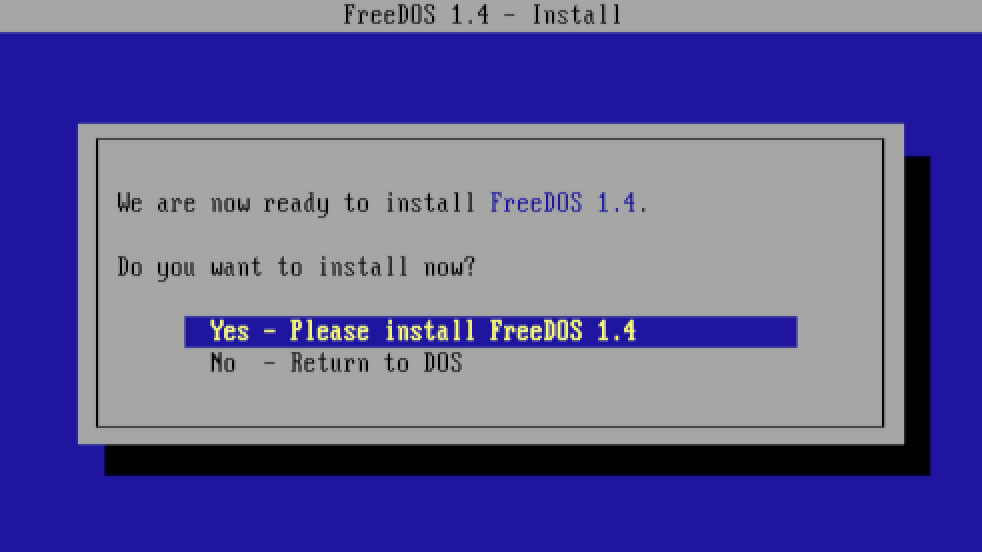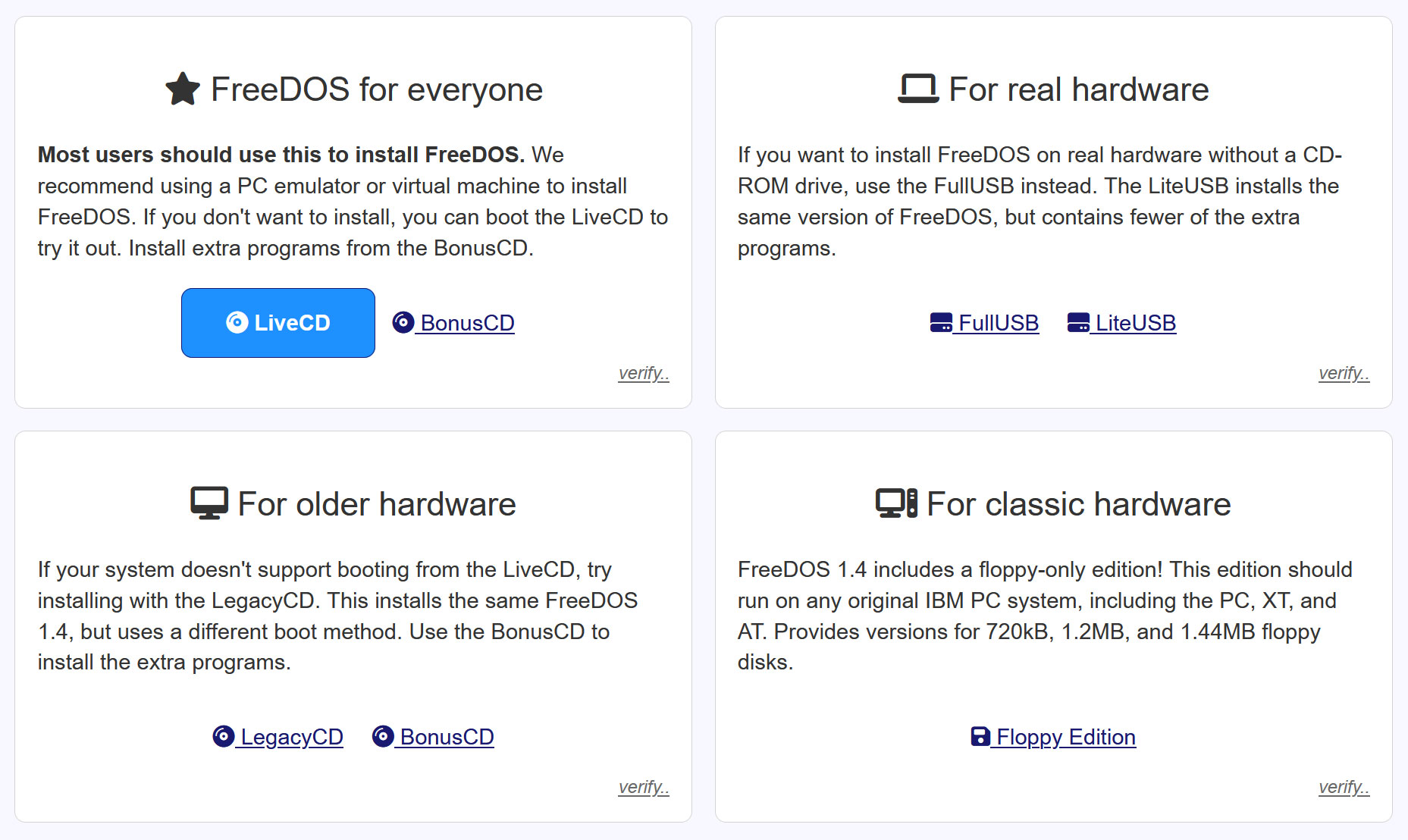FreeDOS 1.4 released with updated FreeCOM, Install program, and HTML Help
Updated free command-line OS comes in multiple formats, from Live CDs to USB flash drives and floppy disks.

The development of FreeDOS marches onwards with the release of version 1.4 of this command-line driven operating system. Influenced, of course, by Microsoft’s MS-DOS (which hasn’t been updated since the year 2000), FreeDOS 1.4 brings with it an updated FreeCOM, Install program, and HTML Help system. An installation also delivers several updated staple utilities, making FreeDOS 1.4 quite a compelling update to version 1.3, which came out in 2022.
Central to this release is a “focus on stability,” which could have a lot to do with the FreeCOM update – the FreeDOS version of the Command.com shell. The release notes for FreeDOS 1.4 explain that the updated FreeCOM includes bug fixes, compatibility improvements, and new translations.
A large behind-the-scenes effort appears to have been made with the installer. FreeDOS has had admirable install flexibility for quite some time. It offers downloads, packages, and media “for everyone,” including a live CD, legacy CD, USB options, and even a good old floppy edition. Knowing its audience, the FreeDOS team also links to several favorite PC emulators, which you can use to install the OS in a virtual machine and run it in a window.
The FreeDOS blog goes into some detail about how the developers streamlined and rearranged packages. In short, that the streamlining involved getting rid of buggy and lesser-used packages. Meanwhile, the touted rearranging means that CD distributions, for example, are leaner and better defined. "The LiveCD installs a complete user-based DOS system including standard DOS programs, Applications, Archivers, Device Drivers, Games, Networking, Sound, and basic tools," explained the FreeDOS admin on social media. “Use the BonusCD to install Development, Editors, Boot Tools, OpenGEM, and extra utilities.”
FDHelp is a new HTML-based help system touted by the developers. It was apparently rewritten from scratch and packs in a number of translations.
Moving onto updated core utilities in FreeDOS 1.4, the release notes highlight that Xcopy has been updated with a more efficient recursive copy. The new Move command has been updated to “limit stack usage reducing the chance of stack overflow on recursive moves.”
For networking, mTCP is claimed to deliver “many changes that improve reliability.” And, last but not least, Fdisk has some important fixes, averting critical errors that caused issues with the previous release.
You can grab FreeDOS 1.4 now, in your format and package of choice. The developers note that “most users should use the Live CD image” to install the OS, especially emulator users. If you are one of those installing on physical and/or older hardware, your needs are covered too.
Get Tom's Hardware's best news and in-depth reviews, straight to your inbox.
FreeDOS enjoyed its 30th birthday last June.

Mark Tyson is a news editor at Tom's Hardware. He enjoys covering the full breadth of PC tech; from business and semiconductor design to products approaching the edge of reason.
-
ravewulf Version 1.3 massively improved game compatibility but Phil's Computer Lab found a couple that still had issues. I wonder if that's improved? Pretty awesome that they include so many install methodsReply -
abufrejoval Bah, I'll wait until DOS 2.5, that is supposed to have multi-tasking, just like MP/M!Reply -
kerberos_20 Reply
or you could just backtrack to win 9x, which at its core is just dos based virtual machine running bunch of type 2 windows/dos hypervisors, just remove windows code/gui and youll end up with dos multitasking enviromentabufrejoval said:Bah, I'll wait until DOS 2.5, that is supposed to have multi-tasking, just like MP/M! -
TerryLaze Reply
It can run windows 3.1...all the multitasking you want.abufrejoval said:Bah, I'll wait until DOS 2.5, that is supposed to have multi-tasking, just like MP/M!
It's extremely hard to do multitasking on a single console anyway, that's why MP/M was a multiUSER and not a multiTASKING os. -
abufrejoval Reply
Yeah, my kids keep complaining about my jokes, too...TerryLaze said:It can run windows 3.1...all the multitasking you want.
It's extremely hard to do multitasking on a single console anyway, that's why MP/M was a multiUSER and not a multiTASKING os.
And while it was very late for April 1st, it wasn't at all serious, but a way to reminisce that there were days when DOS indeed was both "the hottest stuff around" in PCs and even had a future in terms of feature expansion. This was all well before even the 80286, let alone the 80386!
And yeah, there was MP/M, a multi-tasking and multi-user version of CP/M, which was in use before the IBM-PC even launched: plenty of S-100 systems out there used it to support businesses too big for a single microcomputer yet too small for a mid-range system.
I know it's hard to believe these days, but there was a lot of multi-user and multi-tasking going on with RAM sizes of 32-128K and certainly 640K would have been regarded as outrageous in an MP/M setup, most PDP-11 (mid-range) ran with less.
Microsoft did produce a multi-tasking DOS prototype with an internal version number of DOS 2.5. Somehow the company I was working at at the time had documentation, which I was given to read, but I don't think we ever had code for testing and it never left beta, instead the main focus of the next DOS release (3.0) became HDD support and the hierarchical file system (inspired by Xenix).
Digital Research also continued to make multi-user derivatives of their DR-DOS, mostly for embedded use and with GEM UIs, which I was also using for some of my projects back then, long before Windows ever became remotely usable.. -
TerryLaze Reply
Yeah my coding school had one class that was done on a single 68000 for the whole class, the same CPU my amiga 500 had at the same time.abufrejoval said:I know it's hard to believe these days, but there was a lot of multi-user and multi-tasking going on with RAM sizes of 32-128K and certainly 640K would have been regarded as outrageous in an MP/M setup, most PDP-11 (mid-range) ran with less.
No idea how much ram it had though. -
abufrejoval Reply
Well the 68000 had 24 address and 16 data bits, so 16MB was definitely the physical maximum, even with 32-bit registers. But top RAM chips were 64Kbit then and you ran out of space and money before those limits were reached.TerryLaze said:Yeah my coding school had one class that was done on a single 68000 for the whole class, the same CPU my amiga 500 had at the same time.
No idea how much ram it had though.
We had a mostly home-grown multi-user Unix systems based on Motorola 68k at university, but that could have been a 68010, because the 68000 itself didn't yet permit page fault recovery e.g. with the 68451 external MMU. It crashed so often, it didn't last for long and became SunOS domain for a long time thereafter.
The first Unix I ever installed was actually Xenix on a 8086 with a discrete external TTL based MMU. Must have been in 1983 when I was doing an internship waiting for university to start.
I remember it ran Multiplan in multi-user, just like DOS 2.5 would have...
